

  |
|
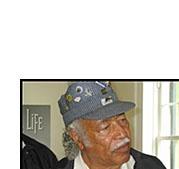 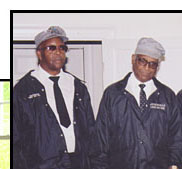 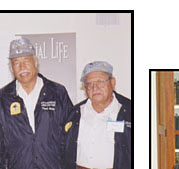 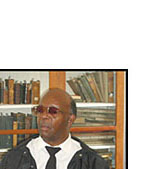 | |
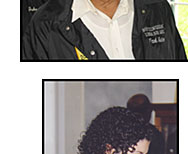 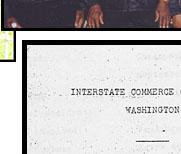  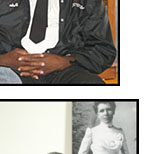 | |
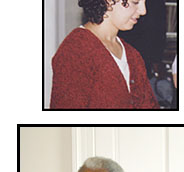 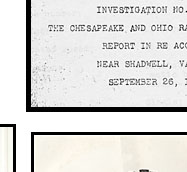 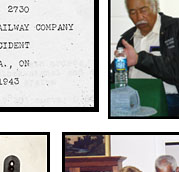 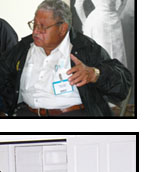 | |
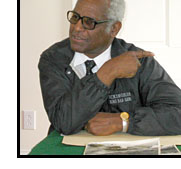 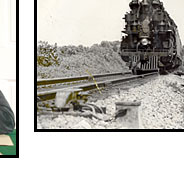  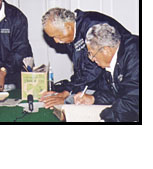 | |
| Pictured above (clockwise from upper left): Francis Austin; John Laury, Charles White, Francis Austin, and William E. Neighbors; John Laury; Francis Austin and William Neighbors describing the wreck of Engine 483 in Sept. 1943 at Shadwell; Buckingham Lining Bar Gang and museum volunteers enjoying railroad history at our Barclay House; Engine 483 circa 1948 (courtesy of Chesapeake and Ohio Railway Museum); Charles White retelling how Clifton Forge railroaders helped clear the Shadwell wreckage; Monica Shenouda, UVA intern at Scottsville Museum, who helped conduct this railroading oral history; and, at center, the official investigation report of the Shadwell train wreck. Photographs by Gwynne Daye and Connie Geary, Scottsville Museum. |
|
Name: Buckingham Lining Bar Gang Date: June 04, 2003 Image Number: Not Available "I got a gal who's long and tall / Sleeps in the kitchen with her feet in the hall." In a rich baritone voice, John Laury chanted these words during his June 4th visit to Scottsville Museum with the Buckingham Lining Bar Gang. Mr. Laury served as the "caller" for this African-American work song during an insightful afternoon of oral history and railroad songs with his colleagues, Francis Austin, William Neighbors, and Charles White. These four gentlemen belong to the Buckingham Lining Bar Gang, a group of ten re-enactors, who live and breathe the traditions of old time Virginia railroad workers. Through their railroading demonstrations, singing, and storytelling, the Gang offers a unique perspective on American life. The Gang members described the way railroad tracks were aligned and maintained before mechanization replaced manual labor. Prior to the mid-1950's, crews of sixteen men aligned tracks by using heavy steel lining bars. This process required careful coordination to ensure the combined strength of the crew heaved the rail with their lining bars at the same moment. One crew member became the "caller," who sang out a two-line rhyme in a loud, clear voice and synchronized other crew members' movement so that their combined sheer strength leaned into the rail all at one time. According to Mr. White, many calls were handed down from generation to generation, and some even dated back 100-150 years. These calls helped make the hard work easier and served an indispensable function of uniting men's efforts, easing their minds, and, as many were humorous in nature, making the railroaders smile. During the oral history discussions led by Gwynne Daye, Connie Geary, and Monica Shenouda, the Buckingham Lining Bar Gang recalled one local railroading experience that particularly caught our attention. Mr. Neighbors described working with a C&O rail crew near Shadwell, Virginia, on September 26, 1943. He was an assistant foreman on a 70-man crew that was installing a new mainline track parallel to the existing mainline and laid on a hillside cut. With the new track scheduled to open the next day, Mr. Neighbors' men worked feverishly to complete a new switch. Due to this ongoing track repair, all trains were issued a 'slow order' with a maximum authorized speed of 15 miles per hour in the area just west of Shadwell. As he watched for trains departing Shadwell less than a mile away, Mr. Neighbors spied a westbound passenger train barreling down on his crew. Engine 483 was pulling eleven cars and 'belching' more steam than a slow-moving train should. "I knew the train was going too fast and ordered my crew off the track and up the hill to safety. That train was going to wreck!" Later, railroad investigators estimated Engine 483's speed at nearly 50 mph when its engineer fruitlessly applied the emergency brakes. The engine hit the soft spot in the new track, derailed, flipped over on its side, and slid down the bank into the Rivanna River. Behind the engine, eight of the cars derailed, and a Pullman car slammed into the hillside a few feet below Mr. Neighbors as he scrambled to safety. When the dust and steam subsided, the rail crew hustled down to help the trainmen and passengers. The engineer and fireman were killed almost immediately by the exploding steam boiler, and the official accident report lists eighteen injured trainmen and passengers, presumably many suffered broken bones from being thrown around in the derailed cars. Mr. Neighbors described seeing hundreds of young men in foreign military uniforms climbing out of the wrecked passenger cars. "They were German prisoners of war, and many spoke better English than I did!" U.S. military police with machine guns scurried out of the cars to guard their prisoners. The 312 German POWs, none older than 21, had been captured in North Africa and were being shipped to western orchards to pick fruit. These young Germans were happy to sit on the hillside, watching the efforts underway to clear the train wreckage. After all passengers were cleared from the train, Mr. Neighbors started his men cutting away some of the wreckage with torches. It was wartime, and the track had to be cleared and repaired for military transport use within 24 hrs. Engine 483 would require a crane to right it and put it back on the track for towing to a repair shop. So Mr. Neighbors jumped into his old 1938 Chevy and drove down Rt. 20 to find Billy Frane, an experienced crane operator who lived near Shores in Fluvanna County. On their return trip to Shadwell, ambulances and cars filled the road from Keene onward. When the two trainmen finally arrived at the Shadwell site, they discovered nearly 5000 spectators had arrived to view the train wreck from a hillside vantage point. Many of them were armed - and Mr. White, who was thirteen and lived in Clifton Forge in 1943, told the rest of the story. One hundred miles away in Clifton Forge, word of the train wreck arrived at the depot that September morning. The need for more manpower to clear the wreckage quickly was detailed. Police Officer Pete Simmons began rounding up local railroad men, many of whom were in church. Soon word spread through the countryside that a German prisoner of war train had wrecked, and the POWs were loose and wandering the countryside. Clifton Forge men were told to bring their guns and help capture the POWs. After the men departed via train for the wreckage site, wives and mothers engaged in fervent prayers for the safety of their men. A few days later, according to Mr. White, a train with 3-4 passenger cars rolled back into Clifton Forge. Out of every window, blue and red handkerchiefs waved as the local railroad men returned to their homes, happy to report the Germans were recaptured but exhausted from long hours of track repair. "Cap'n, Cap'n, can't you see / Linin' this track is killing po' me." The Buckingham Lining Bar Gang headed next to Washington, DC, where the men participated in the Smithsonian's 2003 Folklife Festival. The Gang performed its track lining demonstrations, storytelling, and singing on the Mall to audiences of all ages during June 25-29, 2003. Copyright © 2018 by Scottsville Museum |
|
|
|
Museum
Archive
Business
Cemeteries
Church
Events
Floods
For Kids
Homes
Portraits
Postcards
School
Transportation
Civil War WWII Esmont Search Policy |
||||
|
Scottsville Museum · 290 Main Street · Scottsville, Virginia 24590 · 434-286-2247 www.avenue.org/smuseum · info@scottsvillemuseum.com Copyright © 2018 by Scottsville Museum |
||||